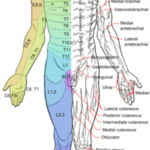Restless leg syndrome (RLS) is characterized by the need to move the legs in order to stop uncomfortable sensations in the legs and feet. RLS occurs most frequently in older and middle-aged adults. Stress can make the symptoms of restless leg syndrome worse. The cause for RLS, in most patients is unknown, but it is known that the disorder occurs more frequently in people who have certain diseases and conditions. Restless leg syndrome may occur more frequently in patients having chronic kidney disease, iron deficiency, Parkinson’s disease, peripheral neuropathy. Pregnant women are also likely to have the symptoms of restless leg syndrome.
Restless leg syndrome can be passed along in families. It can be an issue when symptoms begin at a younger age. (I remember having problems keeping my legs and feet still when I was in my teens.) Restless leg syndrome can result in the patient having insomnia, because the sensations make you aware of your legs. Trying to stop the legs from moving can cause enough anxiety where you cannot slip into sleep. The insomnia caused by RLS can lead to anxiety or depression, daytime sleepiness, and slowed thought processes.
Symptoms of restless leg syndrome
Symptoms of restless leg syndrome include:
Movement – Restless leg syndrome causes sensations in the lower legs which can become uncomfortable unless you continuously shift the position of your legs. The sensations occur during the hours of sleep (night or day) and during times when you are sitting for long periods of time.
Sensations – The sensations can be described as a crawling, aching, burning, pulling, or tingling feeling. Some people even say it feels like a bubbling feeling under the skin. The symptoms can last for an hour or more at a time. The sensations can sometimes be experienced in the feet, upper legs and the arms. People having these sensations often get the urge to get up and walk or move their legs in bed or while sitting up. Moving the legs (or arms if they are affected) relieves the discomfort from the sensations of RLS. Restless leg syndrome is also known as periodic limb movement disorder (PLMD).
Sleep disturbances – The symptoms can frequently disturb the sleep. These symptoms can also make it difficult to travel because sitting for long periods can be very uncomfortable. The symptoms can worsen when you are under stress or emotionally upset.
Diagnostic testing for restless leg syndrome
There is no standard diagnostic testing for restless leg syndrome available. The health care provider may not find any physical irregularities. Sometimes people who have RLS also have peripheral nerve disease (PND). Blood testing for restless leg syndrome (including serum ferritin and CBC) can be done for ruling out anemia and iron deficiency, which can occur in rare cases of restless leg syndrome. Examination and testing is also done to rule out other disorders that could have similar symptoms.
Treatment for restless leg syndrome
There isn’t a specific treatment or cure for restless leg syndrome. Treatment is intended towards stress reduction and muscle relaxation. Warm baths, gentle massages, and gentle stretching exercises helps to reduce stress and relax the muscles in the extremities.
Low doses of Ropinirole or Pramipexole can be extremely effective in controlling the symptoms in some people with RLS. In cases where sleep is disrupted relentlessly, the health care provider can prescribe medications such as Gabapentin, Sinemet, Pregabalin and Clonazepam.
People who have iron deficiency anemia should be treated with iron supplements. Low dose narcotics can sometimes ease the symptoms of RLS. Restless leg syndrome isn’t life-threatening or dangerous; however, it may be painful and cause sleep disturbances. The main complication for restless leg syndrome is insomnia.
Sources:
Medline Plus





